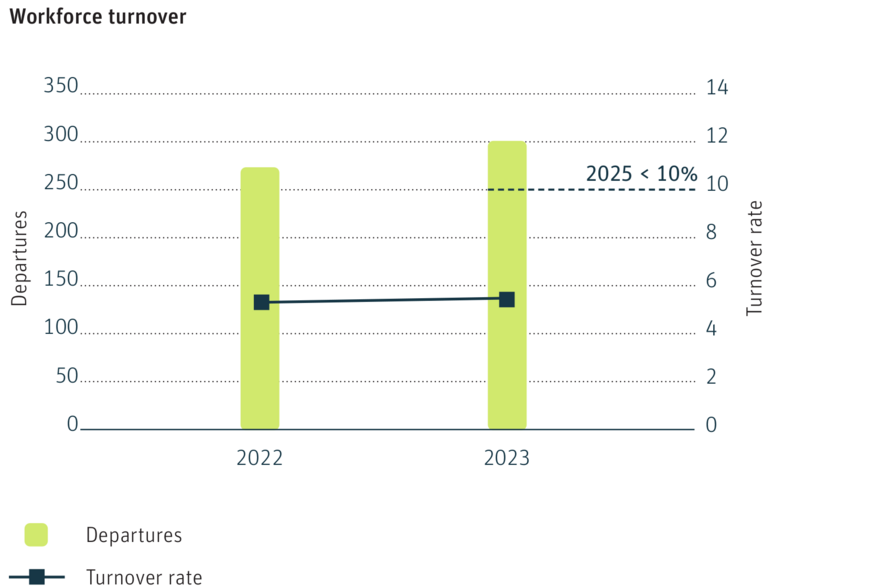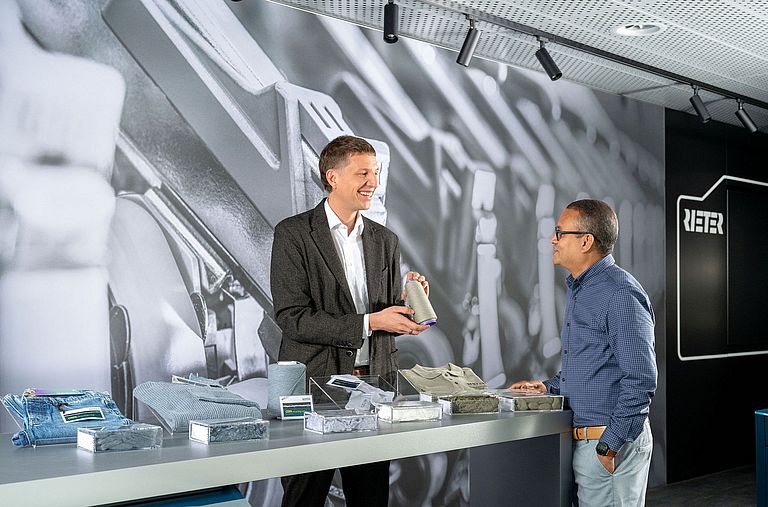
Rieter collects data on employees (GRI-401), Occupational Health & Safety (GRI-403), Women in management positions (GRI-405), training days (GRI-404) and absenteeism.
GRI 401: Employment 2016
Rieter is the technology leader for short staple fiber spinning systems. The company therefore needs highly qualified employees with technical know-how who put the customer at the center of everything they do. Committed and qualified employees help to implement the corporate strategy locally and support customers in exploiting the full potential of Rieter technology. Continuous training is therefore a decisive success factor for the company – but also for the career development of employees.
Disclosure 401-1 New employee hires and employee turnover
At the end of 2023, Rieter employed 5 081 people (full-time equivalents), compared with 5 629 in the previous year. The Rieter Group had 98 apprentices compared to 169 in the previous year. The reduction was primarily due to a realignment of the training approach in India, where employees are developed in a skills competence center. The number of apprentices in Switzerland fell only slightly from 57 to 54. The proportion of employees in Switzerland remained stable at around 16 percent.
With regard to the labor turnover rate, Rieter is now focusing on those employees who leave the company voluntarily because they have found what they consider to be a better alternative. This will allow Rieter to better measure employee satisfaction and the strength of its corporate culture. The number of employees who voluntarily left Rieter in the year under review remained stable at around 5.4 percent, compared with around 5.1 percent in the previous year and around 5.2 percent in the base year 2020. This is well below the 2025 target of no more than ten percent. This is a clear indication that Rieter is an attractive employer and is successful in retaining key talent over the long term.

GRI 403: Occupational Health and Safety 2018
The safety and health of employees are a top priority at Rieter. The “Environment, Health and Safety” (EHS) strategy of the Rieter Group forms the basis and defines clear minimum requirements. The environmental and occupational safety officers at the manufacturing locations are in charge of implementing these requirements. Compliance with these requirements is verified in the context of risk audits and by means of self-testing.
The Rieter Group has an established risk control audit system for all locations. The Corporate Risk and Insurance Management team conducts risk audits at regular intervals in conjunction with an external partner. In addition to standard property insurance risks such as fire and natural hazards, business interruption, occupational safety and environmental risks are also analyzed. The team then informs management at the respective locations of the results, provides recommendations and monitors implementation.
Disclosure 403-1 Occupational health and safety management system
The company has defined minimum requirements based on the "Environment, Health and Safety" (EHS) strategy:
- Safe products and working conditions at all Rieter locations,
- sustainable and efficient use of resources over the entire life cycle,
- compliance with applicable legal requirements and Rieter’s internal guidelines.
The applicable regulations on health and safety in the workplace must be complied with in every country. The sites are responsible for ensuring that the local legal provisions are complied with.
Disclosure 403-2 Hazard identification, risk assessment, and incident investigation
Rieter has an established system for hazard identification, risk assessment and accident investigation. The system has been implemented locally for years and is monitored centrally at group level. Every incident is logged and investigated by means of a root cause analysis, evaluated and supplemented by measures to prevent future cases.
Central processing ensures that all Rieter locations are informed about the root cause analysis and can take preventive measures. The EHS team evaluates all accidents, documents them and records them centrally. Employees primarily in production are regularly trained, made aware of hazards and instructed in the use of workplace safety measures. All training measures are recorded and repeated or refreshed at regular intervals.
Disclosure 403-3 Occupational health services
Each site is equipped with an emergency concept for occupational health services. Rieter thus complies with the legal requirements at the sites and ensures that employees receive occupational medical care.
Disclosure 403-5 Worker training on occupational health and safety
Employees primarily in production are regularly trained, made aware of hazards and instructed in the use of workplace safety measures. All training measures are recorded and repeated or refreshed at regular intervals.
Disclosure 403-8 Workers covered by an occupational health and safety management system
Rieter sites are ISO certified as follows.
| 2022 | 2023 | |
|---|---|---|
| ISO 9001 (locations) | 12 | 12 |
| Employees | 86% | 79% |
| ISO 14001 (locations) | 1 | 1 |
| OHAS 18001 (locations) | 1 | 1 |
| Rieter production locations | 18 | 18 |
Disclosure 403-9 Work-related injuries
The absolute number of occupational accidents decreased to 44 in the year under review, compared to 50 in the previous year. As a result, the accident rate per million hours worked improved to around 4.0, compared with around 4.7 in 2022 and around 5.2 in the base year 2020. The number of serious accidents decreased significantly to 27, down from 36 in the previous year.
A “serious” accident is defined as one in which the person or persons involved are absent for more than three days. Accidents are considered “minor” if they result in no more than three days absence from work. The number of accidents was 17, an increase of three over the previous year.
The improved accident rate is attributable to more intensive preventive measures and the implementation of targeted safety training at Rieter sites. Each accident is investigated in detail and recorded in a case analysis that includes corrective actions. The results are then communicated to all locations for implementation and adaptation. Monthly online meetings with all personnel responsible for occupational health and safety ensure a continuous exchange of knowledge. Rieter’s goal is to completely prevent accidents at work.
GRI 404: Training and Education 2016
Rieter is the technology leader for short staple fiber spinning systems. The company therefore needs highly qualified employees with technical know-how who put the customer at the center of everything they do. Committed and qualified employees help to implement the corporate strategy locally and support customers in exploiting the full potential of Rieter technology. Continuous training is therefore a decisive success factor for the company – but also for the career development of employees.
By 2025, Rieter aims for every employee to spend at least three working days per year on professional training. In 2023, Rieter introduced an online learning platform which currently has access to 2 700 online courses (read more here).
Disclosure 404-1 Average hours of training per year per employee
The average number of annual training days per employee was 1.2, slightly below the previous year’s figure of 1.3 and the base year 2020 figure of 1.5. This means that, in the year under review, it remained below the target of at least three days per year. This is mainly due to the fact that the focus in 2023 was on processing the order backlog. At the end of 2023, the company launched an online learning platform that employees can use to further their own education.
Disclosure 404-2 Programs for upgrading employee skills and transition assistance programs
Rieter’s annual nine-month leadership program combines digital learning opportunities with hands-on exercises. Participants acquire the ability to create long-term value for the company and achieve business objectives. The focus is on developing self-awareness, empathy, and the ability to inspire others. The participants are selected by their line managers and mentored by members of the Group Executive Committee. The induction programs in 2023 focused on the topics of strategy, organization and corporate culture, textile technology and customer knowledge. Each program began with a Q&A session with the CEO.
GRI 405: Diversity and Equal Opportunity 2016
Rieter is committed to equal opportunity. The company attaches great importance to creating an inclusive culture that enables all employees to reach their full potential. In 2023, the focus was on launching a diversity initiative, introducing a learning platform, and developing the next generation of leaders.
Rieter aims to increase the share of women in management positions to over 20% by 2025.
Disclosure 405-2 Ratio of basic salary and remuneration of women to men
The principle of equal pay is an important concern for Rieter. In addition to the wage analyses carried out in Switzerland, which have all confirmed that the principle of equal pay is being observed, similar audits of the remuneration systems will also be conducted at all Rieter locations over the next two years.

Reporting on non-finanical matters 2024
Rieter has a clearly defined sustainability strategy that is closely linked to the Group strategy. In the 2024 Annual Report, the report on non-financial matters shows the progress Rieter has made in the areas of environmental, social and corporate governance.




